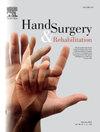Scapholunate reconstruction by arthroscopy: An innovative approach in treating complex joint injuries
IF 0.9
4区 医学
Q4 ORTHOPEDICS
引用次数: 0
Abstract
Background
Scapholunate ligament injuries can lead to chronic wrist pain and instability if not properly addressed. Arthroscopic techniques have evolved to provide minimally invasive solutions, offering excellent visualization and preservation of surrounding tissues. The 360-degree arthroscopic reconstruction technique provides a comprehensive approach, avoiding the use of synthetic implants, which may reduce complications and improve outcomes.
Objective
To describe step by step a 360-degree arthroscopic technique for scapholunate ligament reconstruction and outline all the steps necessary to make this technique practical and easily applicable for hand surgeons worldwide, even without access to specialized materials.
Methods
This technique utilizes autologous (palmaris longus tendon) grafts to reconstruct the scapholunate ligament under arthroscopic guidance, enabling precise and comprehensive repair through a 2.4 mm arthroscope via mediocarpal portals and two mini-incisions—one volar and one ulnar. The procedure completely preserves the integrity of the wrist joint capsule, allowing for early range of motion with minimal restrictions, resulting in high patient satisfaction and minimal morbidity. No synthetic materials or anchors are employed. The technique ensures full circumferential reconstruction around the scapholunate joint, maintaining joint stability while promoting natural healing. Post-operatively, a structured hand rehabilitation protocol is initiated early to promote mobility and function, focusing on reducing stiffness while protecting the repair.
Results
From 2019 to 2024, 17 patients with chronic scapholunate ligament injuries, without radiocarpal or midcarpal arthritis, underwent this technique. There was an improvement in the DASH score in the pre- and postoperative comparison of these patients. The overall average range of motion was 78 degrees of flexion, 66 degrees of extension, 10 degrees of radial deviation, 32 degrees of ulnar deviation, 90 degrees of supination, and 80 degrees of pronation. Radiographic control at 3 months showed no widening of the scapholunate space, and the scapholunate angle was 38 degrees. All patients returned to sports and work without restrictions. The early hand rehabilitation protocol has demonstrated improved recovery times and range of motion when compared to traditional immobilization protocols.
Conclusion
Arthroscopic 360-degree reconstruction without synthetic materials offers a promising alternative for treating scapholunate ligament injuries. When combined with an early rehabilitation protocol, it enhances functional recovery while minimizing complications, making it a valuable technique in wrist surgery worldwide with low cost.
关节镜下舟月骨重建:一种治疗复杂关节损伤的创新方法
如果处理不当,舟月骨韧带损伤可导致慢性手腕疼痛和不稳定。关节镜技术已经发展到提供微创解决方案,提供良好的可视化和周围组织的保存。360度关节镜重建技术提供了一种全面的方法,避免使用合成植入物,可以减少并发症并改善预后。目的介绍一种360度关节镜下舟月骨韧带重建技术,并概述所有必要的步骤,使该技术实用,易于应用于世界各地的手外科医生,即使没有专门的材料。方法在关节镜引导下,利用自体(掌长肌腱)移植重建舟月骨韧带,通过2.4 mm关节镜经内侧腕关节入口和掌尺侧两个小切口进行精确和全面的修复。该手术完全保留了腕关节囊的完整性,在最小的限制下允许早期活动范围,从而使患者满意度高,发病率低。不使用合成材料或锚。该技术确保舟月骨关节周围的全周重建,在促进自然愈合的同时保持关节稳定性。术后,早期开始有组织的手部康复方案,以促进活动和功能,重点是在保护修复的同时减少僵硬。结果2019年至2024年,17例慢性舟月骨韧带损伤患者接受了该技术,无桡腕关节或腕中关节炎。在这些患者的术前和术后比较中,DASH评分有改善。整体平均活动范围为屈曲78度,伸展66度,桡骨偏差10度,尺侧偏差32度,旋后90度,旋前80度。3个月时的x线检查显示舟月骨空间未增宽,舟月骨角为38度。所有患者都恢复了运动和工作,没有任何限制。与传统的固定方案相比,早期的手部康复方案已经证明了恢复时间和运动范围的改善。结论关节镜下无人工合成材料的360度重建是治疗舟月骨韧带损伤的理想选择。当与早期康复方案相结合时,它可以增强功能恢复,同时最大限度地减少并发症,使其成为一种有价值的低成本手腕手术技术。
本文章由计算机程序翻译,如有差异,请以英文原文为准。
求助全文
约1分钟内获得全文
求助全文
来源期刊

Hand Surgery & Rehabilitation
Medicine-Surgery
CiteScore
1.70
自引率
27.30%
发文量
0
审稿时长
49 days
期刊介绍:
As the official publication of the French, Belgian and Swiss Societies for Surgery of the Hand, as well as of the French Society of Rehabilitation of the Hand & Upper Limb, ''Hand Surgery and Rehabilitation'' - formerly named "Chirurgie de la Main" - publishes original articles, literature reviews, technical notes, and clinical cases. It is indexed in the main international databases (including Medline). Initially a platform for French-speaking hand surgeons, the journal will now publish its articles in English to disseminate its author''s scientific findings more widely. The journal also includes a biannual supplement in French, the monograph of the French Society for Surgery of the Hand, where comprehensive reviews in the fields of hand, peripheral nerve and upper limb surgery are presented.
Organe officiel de la Société française de chirurgie de la main, de la Société française de Rééducation de la main (SFRM-GEMMSOR), de la Société suisse de chirurgie de la main et du Belgian Hand Group, indexée dans les grandes bases de données internationales (Medline, Embase, Pascal, Scopus), Hand Surgery and Rehabilitation - anciennement titrée Chirurgie de la main - publie des articles originaux, des revues de la littérature, des notes techniques, des cas clinique. Initialement plateforme d''expression francophone de la spécialité, la revue s''oriente désormais vers l''anglais pour devenir une référence scientifique et de formation de la spécialité en France et en Europe. Avec 6 publications en anglais par an, la revue comprend également un supplément biannuel, la monographie du GEM, où sont présentées en français, des mises au point complètes dans les domaines de la chirurgie de la main, des nerfs périphériques et du membre supérieur.
 求助内容:
求助内容: 应助结果提醒方式:
应助结果提醒方式:


